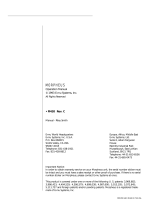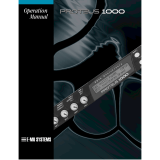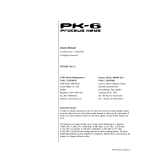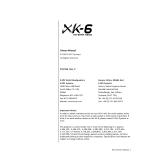Page is loading ...

MINIMOOG MODEL D SYSTEM EXCLUSIVE DATA SHEET
Global Parameters can be accessed using the Power-On Commands detailed in Section 6.1 of the
Owner’s Manual, or via MIDI System Exclusive (SysEx) commands. In addition, System Exclusive data
can be used to create alternate tuning tables for the Minimoog Model D.
SETTING GLOBAL VALUES VIA SYSEX
Use the following data format to set a global value using a SysEx message:
F0 04 15 aa 14 bb cc dd F7
aa = Device ID: 00 to 0A (must match hardware device ID), or 7F to address all devices.
bb = global parameter number
cc = parameter value MSB (will be zero unless parameter value is > 127)
dd = parameter value LSB (range is 0 to 127)
GLOBAL PARAMETER TABLE
This table shows the Global Parameters available via SysEx, as well as the range of values available for each.
(Values are decimal; all SysEx numbers must be hex format)
0 Device ID [0 -15]
1 MIDI Channel In [0 -15]
2 MIDI Channel Out [0 -15]
3 Key Priority
[0 = Low, 1 = Last, 2 = High]
4
Multi_Trigger [0 = Off, 1 = On]
5
Bend_Semitones [0 to 12]
6
poly voice number [0 = poly Off, or 1 to 16]
*not implemented
7
poly voices max [1 to 16] (0 is invalid)
*not implemented
8
Output MIDI Pitch Bend [0 = Off, 1 = On]
9
Output MIDI Pressure [0 = Off, 1 = On]
10
Gate/Trigger Sources
1 = ext. + local
2 = ext. + MIDI
3 = ext. + local+ MIDI]
[0 = ext. gate only
11
Tuning Error [0 = Off, 1 = On]
12
Tuning Variance [0 to 500] (units are 0.1 cents)

13
Tuning Program [0 to 3] (0 = 12TET, 1 to 3 are custom MIDI
tuning standard)
14
Velocity Curve [0 = Soft, 1 = Medium, 2 = Hard]
15
MIDI In Transpose [0 to 24] (Range is -12 to 12 semitones; 12 =
no transpose)
16
MIDI Out Transpose [0 to 24] (range is -12 to 12 semitones; 12 =
no transpose)
17
Pressure CV Range [0 = +5V, 1 = +10V]
18
MIDI Note Zero Volts [0 to 127] (Default is note 36 = 0V pitch CV)
19
Local Control [0 = off, 1 = on] (Keyboard only; not the
panel)
GLOBAL PARAMETER TABLE (CONTINUED)
This table shows the Global Parameters available via SysEx, as well as the range of values available for each.
(Values are decimal; all SysEx numbers must be hex format)
SOME NOTES ON GLOBAL PARAMETERS:
TUNING ERROR
“Tuning Error” is a simulation of the kind of tuning inaccuracy found in the original keyboard of the Model D,
where xed resistors set the tuning of each key on the keyboard. When this option is turned on, a random
amount of detuning (10 cents or less) is applied to each key, and the detuning for a given key is always the
same (representing the tolerance of the original resistors).
TUNING VARIANCE
“Tuning Variance” is the kind of random detuning found on the Sub 37, where the amount of detuning is
different for each key-press. The user can set the maximum amount of detuning, from zero to 50 cents in
0.1-cent increments.
TUNING PROGRAM
“Tuning Program” follows the MIDI Tuning Standard: http://www.microtonal-synthesis.com/MIDItuning.html.
Up to three 128-note tuning tables can be stored in persistent memory.

GLOBAL DEFAULT VALUE TABLE
This table shows the Global Parameters available via SysEx, as well as the range of values available for each.
(Values are decimal; all SysEx numbers must be hex format)
0 Device ID [0 = Device ID 1]
1 MIDI Channel In [Channel 1]
2 MIDI Channel Out [Channel 1]
3 Key Priority
[0 = Low, 1 = Last, 2 = High]
4
Multi_Trigger [0 = Off]
5
Bend_Semitones [0 to 12]
6
poly voice number [0 = poly Off, or 1 to 16]
*not implemented
7
poly voices max [1 to 16] (0 is invalid)
*not implemented
8
Output MIDI Pitch Bend [1 = On]
9
Output MIDI Pressure [1 = On]
10
Gate/Trigger Sources [3 = ext. + local+ MIDI]
11
Tuning Error [0 = Off]
12
Tuning Variance [0 = Off]
13
Tuning Program [0 = 12TET]
14
Velocity Curve [0 = Soft, 1 = Medium, 2 = Hard]
15
MIDI In Transpose [12 = no transpose]
16
MIDI Out Transpose [12 = no transpose]
17
Pressure CV Range [0 = +5V]
18
MIDI Note Zero Volts [36 = 0V Pitch CV]
19
Local Control [1 = On]

SYSEX DOCUMENTATION FOR VELOCITY CURVES
The Model X has three velocity tables in memory which can be programmed via SysEx.
A velocity table consists of two sets of four ordered pairs, where each pair is a time (Uint32, microseconds)
followed by a MIDI velocity (Uint16, range 1 to 127). The time number represents the time between make/
break switches when moving a key, where shorter times correspond to higher velocity. Within each set of
four, the pairs are ordered from shortest time/highest velocity rst, to longest time/lowest velocity last.
Each set of four time/velocity pairs denes four breakpoints on a velocity curve. The rst set is for the
white keys, and the second set is for the black keys (which have shorter time values associated with a given
velocity, due to differences in key geometry).
AN EXAMPLE TABLE
{{6000, 127}, {12500, 65}, {21000, 40}, {62000, 1}}, // white keys
{{3600, 127}, {10000, 60}, {18000, 35}, {52800, 1}} // black keys
Use the following data format to set a Velocity Curve via SysEx:
F0 04 15 aa 0A bb 00 cc (dd...) F7
aa = Device ID: 00 to 0A (must match hardware device ID), or 7F to address all devices.
bb = Command: 00 = get; 01 = set; 02 = restore (all) default curves.
cc = Curve number: 0 = soft, 1 = medium, 2 = hard.
(dd…) = curve data, 32 bytes. Include this section only if setting a new curve (bb = 1).
EXAMPLE 1
device ID 0, get data for curve 1 (medium).
F0 04 15 00 0A 00 00 01 F7
EXAMPLE 2
Device ID “all” (7F), set data for curve 2 (hard).
F0 04 15 7F 0A 01 00 02 00 27 08 7F 00 61 54 37 01 2F 64 1B 04 03 50 01 00 17 38 7F 00 4E 10
37 01 0C 50 1B 03 1C 40 01 F7
(bold text above = curve data)
CURVE DATA IN SYSEX FORMAT [32 BYTES]
{
t1w [3], v1w [1], t2w [3], v2w [1], t3w [3], v3w [1], t4w [3], v4w [1],
t1b [3], v1b [1], t2b [3], v2b [1], t3b [3], v3b [1], t4b [3], v4b [1]
}
Where t...w and v...w are time and velocity respectively for the white keys, and t...b and v...b are time and
velocity for the black keys.
[number in brackets = number of SysEx bytes per value]
Each “t” is three bytes encoding 21 data bits (unsigned integer, value represents microseconds), MSB
rst; max byte value 7F 7F 7F. When these three bytes are assembled into a time value the range is 1 to
0x1FFFFF.
Each “v” is one byte, value range 1 to 7F.
(time or velocity value 0 is not allowed)

ADDITIONAL SYSEX COMMANDS
TRANSMIT FIRMWARE
F0 04 15 7F 16 00 00 00 F7
(Hardware will output keyscan rmware image in SysEx format; can be saved & used to program
another keyscan board if needed)
ERASE FIRMWARE
(Must send this and wait for erase to complete, before sending new rmware)
F0 04 15 7F 11 00 00 00 F7
TRANSMIT FIRMWARE VERSION
F0 04 15 7F 15 00 00 00 F7
(Hardware will output the following:
F0 7E 7F 06 02 04 00 15 00 01 00 00 [v_min] [v_maj] F7
Where v_maj is major version number and v_min is minor version number)
RESTORE DEFAULT GLOBAL SETTINGS
F0 04 15 7F 13 00 00 00 F7
RESTORE DEFAULT VELOCITY CURVES
F0 04 15 7F 0A 02 00 00 F7
RANDOMIZE TUNING-ERROR TABLE
F0 04 15 7F 1A 00 00 00 F7
(“Tuning Error” must be turned on in order to hear any result from this action)
SAVE TUNING-ERROR TABLE TO EEPROM
F0 04 15 7F 1A 01 00 00 F7

CALIBRATION MODE
The Minimoog Model D allows nearly anyone with access to a reasonably good DVM (Digital Volt Meter) to
perform Pitch/CV (PWM) and Pitch Wheel (ADC) calibration procedures to maintain the peak performance
of their instrument. Monitor the voltage output of the Pitch Int. Control Output using a voltage meter
displaying four digits to the right of the decimal point.
START PITCH CV CALIBRATION
F0 04 15 7F 17 00 00 00 F7
START PITCH WHEEL CALIBRATION
F0 04 15 7F 18 00 00 00 F7
START PRESSURE CALIBRATION
F0 04 15 7F 19 00 00 00 F7
KEYBOARD COMBINATIONS AT POWER-ON TO ENTER CALIBRATION MODES
* Bb0, B0, C1, Db1 = start Pitch-CV (PWM) output calibration.
* Bb0, B0, C1, Eb1 = start Pitch Wheel (ADC) input calibration.
* Bb0, B0, C1, E1 = start Pressure (MIDI) output calibration.
PITCH/CV CALIBRATION
This calibration requires setting three values—Low, Zero, and High
1. Press C1 to set the Low calibration value. Using the procedure below, set Pitch output to –2.500 V.
2. Press Eb1 to set the Zero calibration value. Using the procedure below, set Pitch output to 0.000 V.
3. Press F1 to set the High calibration value. Using the procedure below, set Pitch output to +6.500 V.
For each value selected, adjust the output voltage by pressing the following keys:
C3 = decrement coarse (-0.0015 V)
D3 = decrement ne (-0.0003 V)
E3 = increment ne (+0.0003 V)
F3 = increment coarse (+0.0015 V)
The Pitch/CV output adjustment resolution is ± 0.0003 V.
TIP: You can press and hold an increment or decrement key and (after a brief delay) the output adjustment
will repeat automatically until the key is released.
When you are done, press C4 to save your calibration settings; press F0 to exit the Calibration Mode.
PITCH WHEEL CALIBRATION
This calibration requires setting three values—Low, Center, and High.
1. Press C1 to set the Low calibration value. Move the Pitch Bend Wheel to its lowest position
(closest to the front of the keyboard) and press key C4 to save the value.
2. Press Eb1 to set the Center calibration value. Move the Pitch Bend Wheel to the center detent
position and press key C4 to save the value.
3. Press F1 to set the High calibration value. Move the Pitch Bend Wheel to its highest position
(furthest from the front of the keyboard) and press key C4 to save the value.
4. When you are done, press C4 to save your calibration settings; press F0 to exit the Calibration Mode.

THE MIDI TUNING STANDARD
The MIDI Tuning Standard was ratied by the MIDI Manufacturers’ Association in January 1992. Credit
should be given to Robert Rich and Carter Scholz who wrote and lobbied for this addition to the MIDI
specication. Manufacturers have the option of supporting the tuning standard partially or in full.
NON-REALTIME MESSAGES
Use the following data format to request a bulk tuning dump from your synthesizer via SysEx:
F0 7E id 08 00 tt F7
F0 7E = universal non-realtime SysEx header
id = target device ID
08 = sub-ID #1 (MIDI tuning standard)
00 = sub-ID #2 (bulk dump request)
tt = tuning program number 0 to 127 in hexadecimal
F7 = end of SysEx message
For example, request a bulk dump of tuning program 16 from device 1 with the following message:
F0 7E 01 08 00 10 F7
The synthesizer sends the bulk tuning dump in the following format:
F0 7E id 08 01 tt <tn>x16 <xx yy zz>x128 ck F7
F0 7E = universal non-realtime SysEx header
id = target device ID
08 = sub-ID #1 (MIDI tuning standard)
01 = sub-ID #2 (Bulk dump reply)
tt = tuning program number 0 to 127 in hexadecimal
tn = tuning name (16 ASCII characters)
xx yy zz = frequency data for one note (repeated 128 times)
see below for format
ck = checksum
F7 = end of SysEx message
REALTIME MESSAGES
The following message changes the tuning of one or more notes in realtime. The “preferred” method according to
the specication is to change the tuning immediately for any notes currently sounding. The optional method is to
change the tuning only for new notes that follow the tuning message. In reality, the preferred method depends on
what the composer is trying to accomplish and this author recommends a global parameter on the synthesizer to
select between immediate and new note only retuning.
Use the following data format to change the tuning of one or more notes in realtime via SysEx:
F0 7F id 08 02 tt ll [kk xx yy zz]x(ll) F7
F0 7F = universal realtime SysEx header
id = target device ID
08 = sub-id #1 (MIDI tuning standard)
02 = sub-id #2 (note change)
tt = tuning program number from 0 to 127
ll = number of notes to be changed (sets of [kk xx yy zz])
[kk xx yy zz] = MIDI note number, followed by frequency data for note
F7 = end of SysEx message

TUNING PROGRAM & BANK CHANGES
Tuning Programs and Banks are changed using registered parameter number controller messages.
TUNING PROGRAM CHANGE
Bn 64 00 65 03 06 tt (data entry)
Bn 64 00 65 03 60 7F (data increment)
Bn 64 00 65 03 61 7F (data decrement)
n = basic channel number
tt = tuning program number from 1 to 128
TUNING BANK CHANGE
Bn 64 00 65 04 06 tt (data entry)
Bn 64 00 65 04 60 7F (data increment)
Bn 64 00 65 04 61 7F (data decrement)
n =
basic channel number
tt = tuning program number from 1 to 128
FREQUENCY DATA FORMAT (ALL BYTES IN HEX)
xx = semitone (MIDI note number to retune to, unit is 100 cents)
yy = MSB of fractional part (1/128 semitone = 100/128 cents = .78125 cent units)
zz = LSB of fractional part (1/16384 semitone = 100/16384 cents = .0061 cent units)
7F 7F 7F is reserved for no change to the existing note tuning.
©2016 MOOG MUSIC INC. | 160 Broadway St. Asheville, NC 28801
Moog is a registered trademark of Moog Music Inc.
Minimoog is a registered trademark of Moog Music Inc.
The Moog Wordmark is a registered trademark of Moog Music Inc.
The Moog Icon is a registered trademark of Moog Music Inc.
All rights reserved to Moog Music Inc. on all text & graphics here within.
Phone: 828.251.0090
Email: [email protected]
Website: www.moogmusic.com
/






